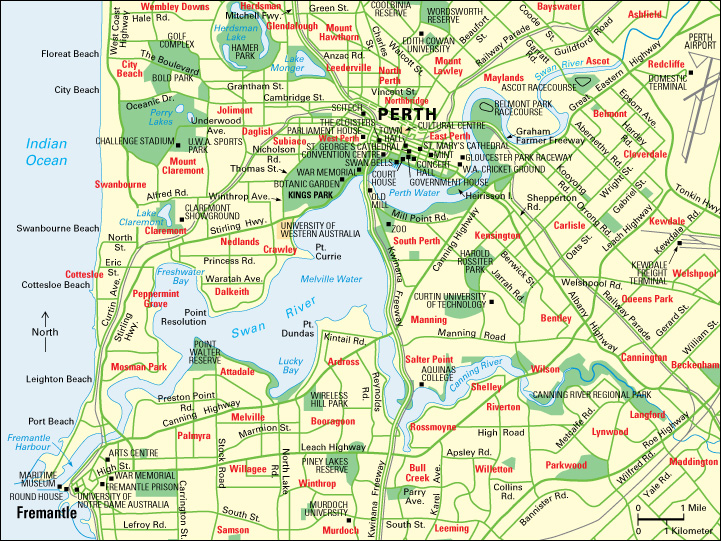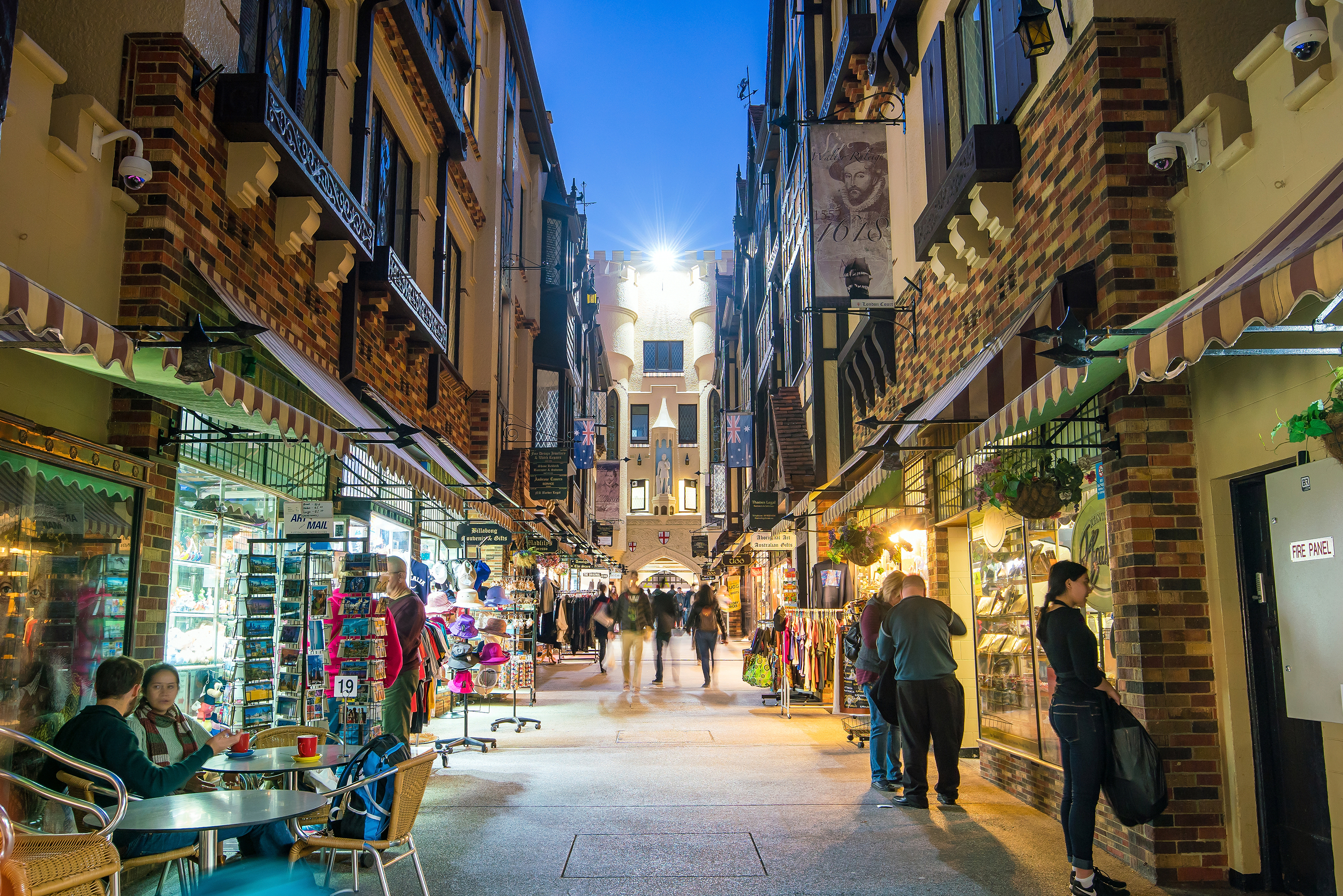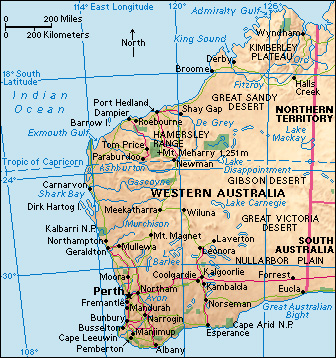Perth (pop. 2,043,762; met. area pop. 2,116,647) is the capital and business center of the state of Western Australia. Perth lies in the southwest corner of the state, on a plain between the Indian Ocean to the west and the hills of the Darling Scarp to the east. Perth is one of Australia’s largest and most beautiful cities. It has well-planned, tree-lined streets and splendid surfing beaches. The majestic Swan River flows through the city.

The metropolitan area
of Perth covers about 2,070 square miles (5,360 square kilometers), stretching from Wanneroo in the north to Mandurah in the south. It includes the busy port city of Fremantle. About four-fifths of Western Australia’s people live in the Perth area.
Central Perth is relatively small and easy to navigate. The business district is about 13 miles (20 kilometers) inland on the northern bank of the Swan River. Two adjoining streets—Saint George’s Terrace and Adelaide Terrace—form the district’s backbone. A pedestrian shopping area includes malls on Hay and Murray streets and a series of arcades. The City of Perth encompasses the areas of Crawley, East Perth, Northbridge, and West Perth. West Perth has its own small business district. 

Perth’s suburbs stretch north and south along Western Australia’s coastline and inland to Mundaring in the northeast and Armadale in the southeast. They have many beautiful parks and lakes that attract large flocks of black swans and other native animals.
High-rise buildings along the banks of the Swan River dominate Perth’s skyline. However, central Perth and its inner suburbs still have many buildings of historical and architectural interest. Among the oldest are the Court House, set in the Supreme Court Gardens; and the Round House, originally built as a jail, at Fremantle. The Australian civil engineer H. W. Reveley constructed both buildings in the 1830’s. They have a simple, modified Georgian style. Perth’s first flour mill, dating from 1835, is across the river from the city center. From 1850 to 1885, builders erected a number of public buildings in the Colonial Gothic style. These structures include Government House; the Town Hall; the Cloisters (originally a school); St. George’s Cathedral, an Anglican cathedral; and St. Mary’s Cathedral, a Roman Catholic cathedral.
People.
Large-scale immigration from Europe to Perth and other Australian cities began in the mid-1900’s. Southeast Asian immigrants began arriving in significant numbers following the Vietnam War (1957-1975). About 60 percent of Perth’s residents were born in Australia. Among those people born overseas, the main countries of birth include the United Kingdom and New Zealand. About 2 percent of Perth’s population identify themselves as Indigenous Australians (people of Aboriginal or Torres Strait Islander heritage). Many students from Asia and Papua New Guinea visit Perth to study. The city also attracts large numbers of tourists from Asia, Europe, New Zealand, and the United States.
Education.
The state provides free primary and secondary education. In addition to the state schools, there is a wide choice of private schools run by church and independent organizations.
The Perth area has several universities. The oldest, the University of Western Australia, was established in 1911. Murdoch University opened in 1975. Curtin University began in 1900 as a technical school. It was called Curtin University of Technology when it first gained university status in 1987. Edith Cowan University, which opened in 1902 as a teaching college, has campuses at Bunbury, Joondalup, Midland, and Mount Lawley. Notre Dame was established in 1992 at Fremantle. Several TAFE (Technical and Further Education) colleges in the area provide adult and vocational education.
Cultural life.
The Perth Cultural Centre includes the State Library of Western Australia, the Art Gallery of Western Australia, the Perth Institute of Contemporary Arts, and the WA Museum Boola Bardip, a branch of the Western Australian Museum. Boola Bardip means many stories in the language of the Whadjuk Nyoongar, an Aboriginal people of the Perth region. The restored Old Women’s Home in Fremantle, built in the 1850’s, houses the Fremantle Arts Centre. The Perth Concert Hall presents musical performances. During the summer, the Music Shell in the Supreme Court Gardens is the site of free outdoor concerts.
Recreation.
Perth has many beautiful beaches, gardens, and parks. The largest and most impressive park is Kings Park and Botanic Garden, west of the business district. It covers 1,000 acres (400 hectares), and much of the land is forested. The park rises along the slopes of Mount Eliza, from which the city and river are visible. The Botanic Garden has many plants unique to the area. Perth’s excellent beaches are popular with water sports enthusiasts. In 1987, the America’s Cup sailing competition took place at Fremantle. It was the first time the event took place outside the United States. The West Australian Cricket Ground, known as the WACA, is Perth’s most famous sporting ground.
Economy.
Perth is an important center for mineral and petroleum production. The headquarters of many of Western Australia’s large mining companies are in the city’s business district.
The nearby cities of Kwinana, Medina, and Rockingham were developed as a heavy industrial site during the mid-1950’s. One of Australia’s largest oil refineries opened there in 1954, followed by a steel-rolling mill and several large chemical, fuel, and metal plants. Cockburn Sound was dredged to create a harbor for the area. In the early 1960’s, one of the world’s largest alumina refineries began processing locally mined bauxite. The area also has a cement works, a paper mill, and a fertilizer plant. Kwinana’s port is one of the world’s largest grain-shipping complexes.
Industries within the City of Perth produce such goods as cement, clothing and food, cranes and tractors, printed materials, and small parts for electrical equipment.
Education, tourism, and food and retail services provide an important share of Perth’s jobs and revenue. In addition, the information technology sector is growing quickly. Fremantle, at the mouth of the Swan River, is the center of Western Australia’s fishing industry. The area is known for its crayfish.
Water supply is a major problem in Perth, largely because of the region’s hot, dry summers. Perth’s water comes from reservoirs in the Darling Range. The reservoirs of the Serpentine Dam, on the Serpentine River, and the Canning Dam, on the Canning River, are important water sources for Perth. Together, they can hold more than 182,000 acre-feet (225 million cubic meters) of water. The Perth Basin, a coastal region, contains accessible groundwater as well.
Perth’s public transport includes suburban train and bus services. A free circular bus service operates in the city center. Ferries on the Swan River carry passengers across the river or between Fremantle and central Perth. Intercity trains connect Perth to Kalgoorlie and Bunbury. Passengers can travel to Sydney, a journey of over 60 hours, on the Indian Pacific railway.
Perth International Airport is at South Guilford, 10 miles (16 kilometers) east of Perth. Private planes and the Royal Flying Doctor Service of Australia, which provides medical service to people in remote areas of the interior of Australia, use Jandakot Airport on the southern outskirts of the city.
Perth has two main newspapers—The West Australian and the Sunday Times. The Australian and Australian Financial Review also have a large circulation.
Government.
The City of Perth Council controls Perth’s central business district and the inner suburbs of Crawley, East Perth, Northbridge, and West Perth. It consists of a lord mayor and eight councilors, who are elected to four-year terms.
Local authorities administer cities, towns, and shires in Perth’s metropolitan area. They handle such matters as the care of park areas, rubbish removal, street maintenance, and town planning.
History.
The Noongar people are the traditional Aboriginal inhabitants of southwestern Australia, including the Perth region. Noongar (also spelled Nyoongar or Nyungar) is also the name of the language of the people. Different Noongar dialect groups are historically associated with different parts of the region. The Noongar name for the Perth area is Boorloo.
The first European to visit the present site of Perth was the Dutch navigator Willem de Vlamingh. He explored the Swan River in January 1697. James Stirling, a British naval officer, visited the area in 1827. Stirling returned to Western Australia as lieutenant governor on June 1, 1829. A group of 69 settlers accompanied him. The colonists attempted to settle on Garden Island, southwest of Perth, but later moved to the site of present-day Perth. On Aug. 12, 1829, Stirling formally declared the establishment of Perth, which was to be the capital of the Swan River Colony. (The colony was renamed Western Australia in 1832.)
Grants of free land attracted many settlers. These grants ceased in 1830. Much of the land was sandy and unsuited to farming. Problems with the land and chronic labor shortages prompted the colonists to request the British government to declare Perth a penal settlement. Convicts, a source of free labor, began arriving in 1850. At that time, other Australian colonies were phasing out transportation, the system of carrying convicts to penal settlements in the British colonies. Convicts continued to arrive in Perth until 1868. Exploration of the western part of the state opened up land for farming and raising animals around present-day Esperance and Geraldton and near the Ashburton, Fortescue, and Gascoyne rivers.
The United Kingdom’s Industrial Revolution of the mid-1800’s sparked a demand for Australian wool. Western Australia prospered, and many fine public buildings were constructed in Perth. Queen Victoria proclaimed Perth a city in 1856. In the 1860’s, Governor J. S. Hampton initiated a building program that included Government House, the Town Hall, military barracks, and a hospital. In the 1870’s, prosperous pastoralists (animal farmers) and pearlers built elegant homes along the Swan River. In 1877, a telegraph line was completed between Perth and Adelaide, the capital of South Australia.
Following the discovery of gold at Coolgardie in 1892 and at Kalgoorlie in 1893, Perth developed rapidly. Many new industries sprang up. Riverland was reclaimed and made into an open space for walks and drives. Suburbs spread to the north and east. In the 1910’s, the city installed such improvements as electric power, gas, and a proper sewerage system. Many suburban residents put telephones in their homes. By 1919, the city government had made plans to create Greater Perth, an administrative area consisting of Perth and a number of nearby communities. It also built roads from Perth to the coast.
Development of Western Australia’s wheat belt and large-scale dairy farming in the state’s southwest contributed to Perth’s prosperity until about 1930. That year brought an economic depression. Unemployment in Perth and elsewhere in Australia rose to a historic high. Farmers moved to the city to look for work.
When World War II ended in 1945, Perth was crowded and run-down. The city’s infrastructure and public services had been neglected because many workers had been involved with the war. In the postwar years, a vigorous immigration policy increased the labor force and aided Perth’s recovery. Many new factories were built during the 1950’s and 1960’s, and industrial and residential suburbs grew rapidly. In 1962, Perth hosted the Commonwealth Games.
A mining boom in the 1970’s led to further industrial expansion. During the 1980’s, many office buildings and hotels sprang up in the city. Development projects begun in the early 2000’s include the Perth City Link to improve commuter railway service, the Elizabeth Quay redevelopment project along the Swan River, and the Yagan Square commercial development in the city’s Central Business District.
Early 2020 brought the health care and economic challenges of the COVID-19 pandemic (worldwide epidemic) to Western Australia, as it did to other regions of Australia and the world. Australia’s federal, state, and territorial governments took action to try to limit the spread of the disease and ease the financial hardships it caused.
